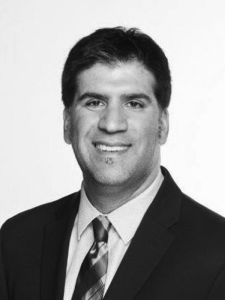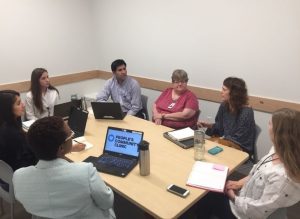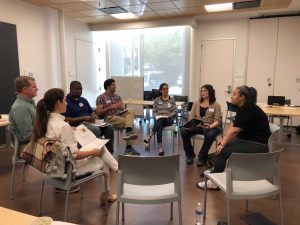Access to Comprehensive Integrative Pain Management for People in the Safety Net
An interview with Sharad Kohli, MD
 You work at People’s Community Clinic – what kind of a clinic is this?
You work at People’s Community Clinic – what kind of a clinic is this?
People’s Community Clinic (PCC) is a Federally Qualified Health Center (FQHC) in Austin, TX, serving nearly 20,000 people who are uninsured and underinsured in Central Texas. PCC offers an Integrative Pain Management Program which provides comprehensive pain care consisting of trauma-informed behavioral health services, nutrition, acupuncture, substance use services, a medical-legal partnership, group visits, and more.
What is an FQHC (background for readers)?
Federally Qualified Health Centers are community-based health care providers that receive funds from the Health Services & Resources Administration (HRSA) Health Center Program to provide primary care services in underserved areas. According to the HRSA, 1 in 12 people across the United States rely on FQHCs for care including 3.5 publicly housed patients, 1.4 million homeless patients, 1 million agricultural workers, and more than 355,000 veterans. FQHCs must meet a stringent set of requirements, including providing care on a sliding fee scale based on patient’s ability to pay and operating under a governing board that includes patients. More information about FQHCs can be found here.
Why do you think FQHCs are important systems to provide comprehensive integrative pain management (CIPM)?
FQHCs are the largest health care network in the country, serving around 30 million patients. This number is increasing rapidly as people have been losing their jobs and their employer sponsored health insurance due to COVID-19, and often don’t have any place else to turn for care. Many of our patients have experienced deep trauma due to racism, discrimination, and poverty, so we see high rates of behavioral health conditions, substance use disorders, and chronic pain, as well as other chronic conditions.
The nice thing about FQHCs is that the care is already integrated. Most FQHCs already provide primary care, behavioral health, dental, and other supporting services often addressing social needs and upstream determinants of health, which makes coordination and integration easier. Many have in-house behavioral health services and can bill Medicare and Medicaid at the full PPS rate. (Publisher’s note: CMS established the FQHC Prospective Payment System (PPS) for medically necessary primary health services and qualified preventive health services given by an FQHC practitioner. Click here to find a good overview of the billing in FQHCs.)
However, access to other non-pharmacologic therapies is exceedingly difficult, and this is largely because, depending on the state you are in, regulations do not typically include reimbursement for the providers of those therapies.
How does Medicaid expansion affect access to comprehensive integrative pain management?
The lack of Medicaid expansion in Texas continues to create barriers to care, including around pain. Most of my adult patients are uninsured, and thus can’t easily get imaging, see an orthopedist, rheumatologist, or pain management specialist, can’t go to physical therapy, and wouldn’t normally have access to acupuncture, chiropractic, massage, yoga, etc. As a result, most of our practitioners can’t prescribe effective non-pharmacologic treatments that are aligned with current recommendations and guidelines from Health and Human Services, the Centers for Disease Control, American College of Physicians, and others. We essentially did not have any choice but to create our own pain management program.
How did your FQHC use HRSA grants to expand access to effective non-pharmacological treatments?
In 2017, as the opioid crisis was growing, HRSA provided grants to FQHCs to mitigate opioid prescribing and treat substance use disorder. All FQHCs were eligible for $150,000, half of which were ongoing funds for staff. Many FQHCs used it to expand access to Medication Assisted Treatment while some, including ours, hired or contracted with substance use counselors. I joined our clinic in January 2018 and recognized that we had a lot of resources, but they needed to be better coordinated to effectively address pain. Some of the remaining funds covered my time to allow me to work on building and integrating a pain program. We already had a robust trauma-informed behavioral health department, nutrition and cooking classes, a medical-legal partnership (which could help with disability claim denials and addressing other health-harming legal needs which could increase patients’ stress and pain), and a partnership with our local Chinese Medicine school, AOMA, who had been running student acupuncture clinics. It took us only a few months to integrate these services, the most important piece of which was creating weekly case conferences where we could all sit together, learn from one another, and discuss complex cases. We also began offering chronic pain group medical visits as a way to allow patients to support and learn from one another (and for us to learn from them).
Weekly case conferences for staff to discuss complex cases sounds great; was this reimbursed?
 No. There is no reimbursement for this in the FQHC model, but we knew it was extremely important so we carved out the time. It has been a highly effective use of time to coordinate and integrate care for patients with complex cases. It also has been great for provider satisfaction as it really is a joy to work with the other team members. There is so much we each bring to the table, and we learn so much from one another, especially our lawyer and social workers, who are essential pieces of the program given that our patients have a multitude of social needs that often have to be addressed first before we can really delve into their pain. It’s also great to have our acupuncturist (as well as his students) at these case conferences, as he provides a different and refreshing perspective compared to what most of us have been taught.
No. There is no reimbursement for this in the FQHC model, but we knew it was extremely important so we carved out the time. It has been a highly effective use of time to coordinate and integrate care for patients with complex cases. It also has been great for provider satisfaction as it really is a joy to work with the other team members. There is so much we each bring to the table, and we learn so much from one another, especially our lawyer and social workers, who are essential pieces of the program given that our patients have a multitude of social needs that often have to be addressed first before we can really delve into their pain. It’s also great to have our acupuncturist (as well as his students) at these case conferences, as he provides a different and refreshing perspective compared to what most of us have been taught.
You mentioned group medical visits which are being discussed and used more often in many different settings. Does your FQHC receive reimbursement for group visits?
Yes, but you have to be clear about how to bill. There is confusion about this at a CMS level and I think it’s partly why many FQHCs shy away from groups, even though they can play an instrumental role in pain care. The regulations state that you cannot bill group visit E/M Codes in FQHCs (e.g. 99078). However, CMS has been very clear to say that it is allowable to use individual codes (e.g. 99212, 99213) as long as there is a medically necessary face-to-face visit with a billable provider (which in FQHCs are MDs, DOs, NPs, PAs, and CNMs), even if there are other patients present. That’s why groups typically have a provider included, even though the real benefits of the group come from elsewhere. I would also add that AAFP has some good guidance, even though it is not specific to FQHCs. This has been confirmed multiple times for FQHCs with direct correspondence to CMS.
 What do you think is important about group visits and access to them?
What do you think is important about group visits and access to them?
I think group medical visits are extremely effective because of the importance of the group dynamic, or as Dr. Jeff Geller calls it, the “Group Inclusion Effect.” So many of our patients are lonely and isolated, which often worsens their pain, and when they are able to come together and realize that there are others who are going through something similar, they often feel less alone and more supported. Patients end up willing to try things that they might not otherwise because perhaps another group member went to acupuncture and it really helped them, or someone has been drinking ginger-turmeric tea and noticed improvement in their pain. People make friends in the groups. Group members hold each other accountable. The groups really help create a sense of community which is so important for healing and well-being.
Can you share an example of difference in reimbursement in state Medicaid between your experience in an FQHC in California and now in Texas?
One example off the top of my head is for chiropractic care. California Medicaid will pay FQHCs the full PPS rate, while in Texas, even though chiropractors are eligible for payment through Medicaid, the FQHC only gets $20-40 for the service, and it’s only for very specific services. The regulations and rates vary state by state, so there are many inconsistencies that affect utilization and access.
What happened with the second round of funding from HRSA?
In mid 2019, HRSA offered more ongoing funding for FQHCs in their efforts to battle the opioid epidemic. In their RFP, for the first time that I had ever seen, they specifically said that if a goal of your program is to more effectively address chronic pain, those funds could go towards covering complementary and integrative practitioners. In our application we described what we were building, and the main gap we had at that moment was a care coordinator who could help manage everything. That took up the bulk of the funding, but we also requested money to expand acupuncture, and add massage therapy and yoga therapy (essentially to offer one day a week of each service). HRSA accepted our proposal and we even received more funds than we had requested. We were able to expand acupuncture rather quickly since the acupuncturist was already working in our clinic, but it took longer for yoga therapy and massage therapy. The biggest obstacle was credentialing as those practitioners needed to be added to our scope and FTCA malpractice (which isn’t hard, but just takes a little time). We finally had a bilingual-bicultural yoga therapist ready to go at the end of March, but COVID hit so we weren’t able to have her begin. We just recently purchased Zoom and will begin to offer virtual one-on-one yoga therapy. Massage unfortunately will have to wait.
How did you know how to build this program in your FQHC?
We were going off my experience building a similar program at an FQHC in California, best practices that had been shared over the years through the Integrative Medicine for the Underserved (IM4US) Conference, as well as the California Health Care Foundation’s 2016 White Paper on effectively treating pain in the safety net. When the HHS Pain Management Best Practices Inter-Agency Task Force report was released in May 2019, it validated what we had been building, that we were essentially adhering to best practices.
What outcomes have you seen?
We have been collecting data, but since it still is pretty early, we don’t have a lot that we can share. We have been using traditional metrics that look at pain and functioning, mental health, and physical health, but we have also started thinking about how we can effectively measure quality of life. Patients don’t generally care if their PHQ-9 score has improved, but it matters to them if they can return to the things that they have always loved doing. We are beginning to pilot the Flourishing Measures, but I will say the most powerful things we have at this point are testimonials from our patients who have gone through the program, including this one from a patient who is also now our Board Chair (in FQHCs, 51% of your Board must be made up of patients).
How has COVID-19 affected this progress in your clinic?
COVID-19 is disproportionally affecting our patients, most of whom come from communities of color, and it is highlighting the institutional racism within our health care system and society. Many of our patients are deemed essential workers who work in jobs like construction or food service and can’t work from home, so they are more exposed to catching the virus; many have lost their jobs and are at risk of losing their housing as they struggle financially; many have underlying health conditions that put them at higher risk from COVID-19; and many can’t obtain health insurance, so are very limited in the services they can access. Given these factors, and the fact that patients may be less mobile and more isolated during this pandemic, we anticipate that patients living with chronic pain will experience more stress, depression, anxiety, substance use, and ultimately more pain.
Unfortunately, the virus has changed so much about how our clinic can operate. At a time when our patients may really need the support of our pain program, we’ve had to limit our in-clinic offerings. We’ve had to cancel our acupuncture, group visits, and cooking classes, and as I mentioned, we’ve postponed starting our yoga therapist. There’s still so much more that we can do, and it will be interesting to see how everything shifts in a post-COVID world. We have begun offering virtual behavioral health visits, and with Zoom, we plan on bringing back group visits, nutrition, yoga, and more. We’re looking at whether we can offer videos on-demand for mindfulness, acupressure, or qi gong. We also are working on protocols to safely restart acupuncture.
Do you know how many other FQHCs are providing evidence-based non-pharmacological therapies integrated in the care provided?
Unfortunately, I really don’t. I know many are, but I don’t think it’s the majority by any means, likely due to all the barriers we have discussed. It would be great to survey all the FQHCs nationwide, learn what clinics are offering their patients for pain, and see who is subscribing to the best practices recommended by HHS. Organizations like IM4US, who have been promoting this work for a decade, and the Integrative Health Policy Consortium could potentially work with the National Association of Community Health Centers and the Bureau of Primary Health Care (a division of HRSA that administers the Health Center program) to conduct the survey and offer trainings on how these types of comprehensive integrative pain programs can be built in FQHCs.
FQHCs are incredibly resourceful because we have to be, and I think it’s pretty easy to convince health centers to add evidence-based non-drug approaches because it fits within our ethos of already providing integrated care with behavioral health, nutrition services, medical-legal and more. But I think one of the big things that needs to happen to really make this accessible is a change around reimbursement. If services like acupuncture, chiropractic, massage, and yoga are not reimbursed, it’s pretty unlikely that most health centers are going to be able to incorporate them in a sustainable manner. It’s going to take advocacy, with more health centers demonstrating the benefits of these programs and more patients telling the stories of how this type of care has really helped them. If we can solve this, I’m convinced that the majority of FQHCs will follow suit and we can change the paradigm of pain care in this country.
Trackbacks/Pingbacks